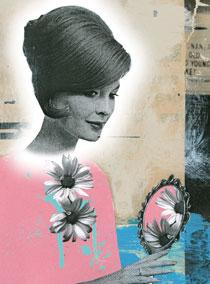Issue Archive
Commentary: On Beauty, an Inner Debate

Whether you think Vashti or Esther is the hero of the Purim story, you will not find a resolution to today’s beauty dilemma by the end of the tale. No rabbinic midrash about inner beauty, no feminist theory about true empowerment, no Marxist explanation of capitalist commodification can satisfy the lifelong search of a Jewish woman for a consistent stance toward her face and body.
I have attempted every position on the matter, wavering between love and loathing of how I look, how I feel about how I look, how much time I spend thinking about how I look, how much time I spend thinking about how I look while trying to look as if I don’t spend any time—or money—on how I look: You get the point.
Religiously, i believe that radiance is a quality of the soul. But I embrace the equally compelling argument that our Creator would not have given us bodies if it were not an act of praise to adorn them. We are obligated to care for them as vessels, for our lives are a gift that does not belong to us. Partners in creation, we honor our bodies so that we can undertake the work of redeeming the world.
By my forties, I had made my peace with my physical self, casting off the self-scrutiny and exaggerated assessment, feature by feature, that afflict 99.9 percent of us, whatever our looks.
Then I turned 50. Suddenly I was the target of a ubiquitous billion-dollar industry called: Intervention.
Who knew there were so many ways to spend money on my looks? And how could I arrive at an attitude that would satisfy my vanity, my Judaism and my wallet?
My friend F. proclaimed when we were in our twenties that she was looking forward to middle age, when she would “let herself go.” Two decades later, she shows no sign of it.
My friend R., ravishing at every age, told me in a tone that brooked no dissent that she was “going white,” slowly ushering in her natural gray. It turns out one’s hair needs considerable monthly attention and funding to make that look work. R. is not skimping.
I cannot explain my generation’s obsession by invoking evolutionary biology. No one our age is mating in order to procreate. Nor does the still-sexist workplace, which privileges youth, sufficiently account for the escalating deployment of peels and injectibles, lasers and scalpels. Not to mention hundred-dollar unguents, justified only in the case of Esther, whose beauty saved her people.
The theological reality is that every penny spent on my looks is money that could go to someone afflicted by hunger or violence for whom this conversation is an unimaginable frivolity.
How do I find an uneasy peace? By recalling the women and men I knew who were remarkable baalei hesed, unceasing in their daily acts of lovingkindness, while fabulously elegant and immaculately groomed. Their vanity was also life sustaining. In spite of diminishing strength and dehumanizing hospitalizations, they “made an effort” with signature flair, delighting their Creator—and all who loved them—until their last valorous breath.
Fashioned of earth, every one of us returns to it. I sometimes imagine the firming agents and face lifts as futilely defiant of gravity. Promoted to support our flesh’s upward mobility, they cannot offset its need to fall. Inevitably, we grow softer, until—if we’re lucky—we have the silky skin of our grandmothers, whose faces were gorgeous to us and whose gaze conferred the kind of beauty that cannot be purchased.
Nessa Rapoport’s most recent book is House on the River: A Summer Journey (Harmony). © 2007 by Nessa Rapoport.










 Facebook
Facebook Instagram
Instagram Twitter
Twitter
Leave a Reply